Evaluation of Accoya Wood as Cladding for Rainscreen Facades
Info: 8607 words (34 pages) Dissertation
Published: 19th Nov 2021
Abstract
As consequence of the growing emphasis on sustainability, the particular demand of new wood materials such as modified timber products, is increasing.
The first part of this report, addresses the historical development of facades as well as different cladding materials used for rainscreen facades.
The second part of this report, addresses the suitability of Accoya, a timber product which has been chemical modified with an acetylation process, as an alternative to other materials for its application as cladding material for rainscreen facades.
Click to expand Table of Contents
Table of Contents
1. Introduction
1.1. Background
1.2. Problem Statement
1.3. Aim and Objectives
1.4. Methodology
2. Literature Review
2.1. Historical Development of Façade
2.2. Facades Typologies
2.3. Rainscreen Facades
2.4. Cladding Materials
3. Timber as Cladding Material in Rainscreen Facades
3.1. Characteristics of Timber as Façade Material
3.1.1. Natural Durability
3.1.2. Directional Variation
3.1.3. Moisture Content
3.1.4. Fibre Saturation Point
3.2. Types of Timber Cladding
4. Modified Timber
4.1. Chemical Modification
4.2. Thermal Modification
4.3. Surface Modification
4.4. Impregnation of Wood
5. Accoya. Acetylated Wood
5.1. Sustainability
5.2. Change Properties by Acetylation
5.2.1. Reducing the Moisture Content of the Cell Wall
5.2.2. Dimensional Stabilisation
5.2.3. Durability. Biological Degradation
5.2.4. Mechanical Properties
5.2.4.1. Strength
5.2.4.2. Hardness
6. Case Studies
6.1. Alps Villa by Camillo Botticini in Lumezzane. Italy
6.2. Europe Conference and Exhibition Centre in Vitoria. Spain
7. Conclusion
8. References
List of Figures
Figure 1. Contribution of CO2 emissions associated with the manufacture of the materials. (Capilla, et al., 2010)
Figure 2. Global building sector consumption and intensity by sector, 1990-2014
Figure 3. Gallarus Oratory. Ireland
Figure 4. Mesa Verde National Park. Colorado
Figure 5. High Line Building. New York
Figure 6. Home Life Insurance Building. Chicago
Figure 7. Rainscreen Facade operation
Figure 8. Palaon Centre clad in aluminium by Holzer Kobler Architects. Germany
Figure 9. Walt Disney Concert Hall clad in stainless-steel by Frank Gehry. Los Angeles
Figure 10. Lawrence Public Library clad in Terracotta by Gould Evans. Kansas.
Figure 11. Diagram of terracotta rainscreen facade
Figure 12. Gherkin Building by Norman Foster. London
Figure 13. Contemporary Art Centre clad in GRC by Nieto Sobejano Architects. Cordoba. Spain.
Figure 14. Heartwood Sapwood diagram
Figure 15. Timber log showing radial, transverse, tangential surfaces
Figure 16. Weathering effects produced over the time on uncoated Scotlarch cladding at Raigmore Hospital by Russwood.
Figure 17. Stages in wood drying. Fibre saturation point
Figure 18. Beechwood Campus by Russwood. Highlands (Scotland)
Figure 19. Royal Veterinary Collage by Russwood. Edinburgh (Scotland)
Figure 20. Ogden Centre for fundamental Physics at Durham University by Studio Libeskind
Figure 21. Community Rowing Club in Boston by Anmahian Winton Architects
Figure 22. Accoya Reaction Schematic
Figure 23. Accoya procurement process
Figure 24. Reduction of the equilibrium moisture content
Figure 25. Acetylated pine stakes in the fungus cellar soil beds after 7 years exposure. Test by Scion, New Zealand Forest Research Institute
Figure 26. Acetylated pine stakes removed from the soil beds in the fungus cellar after 7 years exposure. Test by Scion, New
Figure 27. Wood after termite test
Figure 28. Alps Villa by Camilo Botticini
Figure 29. Europe Conference and Exhibition Centre in Vitoria. Spain
List of Tables
Table 1. Facade typology depending their system and composition
Table 2. Classification of the most common cladding materials
Table 3. Characteristics of timber as facade material
Table 4. Natural durability classification against fungi attack (BS EN 350 2016).
Table 5. Different types of timber cladding
Table 6. Greenhouse gas emissions of several building materials per cubic meter based on a cradle-to gate scenario
Table 7. Dimension Stability
Table 8. Durability comparison
Table 9. Weight losses. Termite test
1. Introduction
Accoya is the brand of wood that has been modified by acetylation. Modified wood is a term used to describe wood whose molecular composition has been altered, usually by chemical or thermal processes. These processes differ from conventional preservative treatments where the wood is impregnated with a biocide. The range of modified wood products in the United Kingdom is increasing considerably and, when their specification is made, it is necessary to consider them individually because their properties vary considerably. (Trada Technology Ltd, 2011)
In the last decades the acetylation of the wood has been extensively studied due to it improves the resistance of the wood against decomposing fungi, as well as improving its dimensional stability under variable humidity conditions. (Alexander, et al., 2013). Although Accsys Technologies introduced acetylated wood, named Accoya wood, into the market in 2007, research on acetylated wood began as early as 1928.
Although the manufacture of the Accoya has proven its effectiveness in different ranges of soft woods and hardwoods, radiata pine is the species of wood currently used for the manufacture of Accoya. Radiata pine is obtained in a sustainable way and, since acetylated wood can be reused, recycled and disposed of without the risk of environmental damage, Accoya offers an alternative to using preservative treated wood (or increasingly scarce woods) for applications where there is a risk from decay. (Trada Technology Ltd, 2011)
Accoya wood is mainly used for non-structural applications such as joinery, cladding, decking and civil works. This product is widely used in United States, Netherlands, UK and Germany.
1.1. Background
Timber has been used as a construction material for thousands of years and is still useful for builders and architects to this day. As time passes, developments in various types of wood components are available and their use in different structural forms have occurred; New advanced wood products are now available that allow structural engineers to achieve the performance and efficiency in the construction of the shapes demanded in the 21st century. (Turgut, 2007). As a natural and renewable building material, timber has excellent ecological attributes. It acts as a carbon sink and has low embodied energy. The energy needed to convert trees into wood and hence into structural timber is significantly lower than that required by other structural materials such as steel and concrete. (Capilla, et al., 2010)
Cladding of buildings is an important and commonly applied area of activity in the construction sector. The main purpose of the cladding is to separate the interior environment from the exterior in such a way that the conditions of the interior environment can be maintained at a level suitable for the intended use of the building. Therefore, from the functional point of view it can be defined as the outer wall of the building that must defend the interior spaces against the invasion of water, wind, sun, light, heat and cold, and all other forces of nature. In addition to this, it must also comply with the aesthetic, economic and safety considerations. (Turgut, 2007).
The design of the building façade has become much more complicated with development of new construction methods, the requirements for a highly controlled interior environments, the emphasis on energy efficiency, advent of new materials and new production methods.
1.2. Problem Statement
Construction as a global industry consumes 60% of the raw materials extracted. In Europe, the extractions represent 4.8 tons per person. This extreme rate of product disposal will lead to large environmental impacts. As shown in Figure 1. Concrete and steel are the main contributors to CO2 emissions whereas wood products only produce 1.1%. (Capilla, et al., 2010). Therefore, the use of wood in construction should be encouraged.
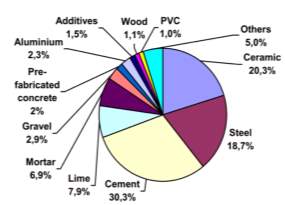
Figure 1. Contribution of CO2 emissions associated with the manufacture of the materials. (Capilla, et al., 2010)
Energy use in buildings represents approximately one third of final global energy consumption and accounts for almost 20% of greenhouse gas (GHG) emissions worldwide. (Unep, 2016).
These high levels of energy use and industrial emissions can be reduced by the use of alternative construction materials with lower emissions. Because wood captures much more carbon than is emitted during manufacturing, the use of wood accounts for more than 100% of the reduction in fossil fuel emissions compared to other materials. (Fernandez-Solis, et al., 2013).
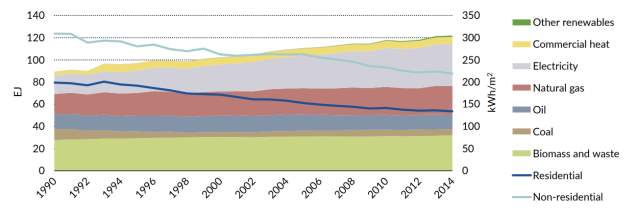
Figure 2. Global building sector consumption and intensity by sector, 1990-2014
The timber industry offers alternative Modern Methods of Construction which are based on prefabrication. The increase levels of offsite result in standardisation and correspondent automation and as a result there is the misconception that it results in the deskilling of traditional trades. Thanks to offsite manufacturing processes and prefabrication, using timber systems means significant advantages and significant time savings to be made using offsite modular construction. (Hairstans, 2018)
1.3. Aim and Objectives
The aim of this report is to evaluate the use of Accoya (a modified timber product) as cladding to the construction industry. Accoya will be installed as cladding on the proposed design for the Paisley Cultural Centre, which comprises a theatre and a library.
The objectives are:
- To investigate the benefits and limitations of using Accoya as cladding to the construction industry.
- To understand how the installation of Accoya on rainscreen facades may affect the performance of the building compared to different types of timber products.
1.4. Methodology
The methodology chosen for the development of the actual paper comprised an analysis of the information provided by other academic sources in form of books or research papers.
Followed by an analysis and comparison of technical data provided by different manufactures. All this information has been applied to the proposed design for the library at the Cultural Centre of Paisley.
2. Literature Review
2.1 Historical Development of Façade
It is important to describe the history of facade to better analyse its significance and functionality in building. The term Facade is a French word derived from the Italian word "Faccia" meaning face. The façade is "The exterior face of a building which is the architectural front, sometimes distinguished from the other faces by elaboration of architectural or ornamental details." (Harris, 2000)
Building began with simple forms of construction being used for shelter from the wind, sun and rain. Gradually, as the desire for better shelter grew, suitable materials were identified, and construction skills were developed. Vernacular architecture throughout the world is usually characterized by the judicious and advantageous use of readily available local materials and an experiential understanding of climate and site. (Fitch, et al., 1960) These forms of building evolved over generations and, since the requirements were relatively simple and change was usually very slow, the design, the building materials and the construction techniques evolved at a pace dictated by matching need and available resources.
Figure 3. Gallarus Oratory. Ireland
For several thousand years, walls in Europe were built of masonry, wood, or clay material. Because of their size or massiveness, these walls were exceptionally strong and durable and provided thermal protection through their natural heat storage and thermal insulation capabilities.
Figure 4. Mesa Verde National Park. Colorado
The Industrial Revolution dramatically changed the situation, leading to the rapid development of new materials, products and techniques. New forms of energy generation and equipment facilitated space conditioning and extended humankind's environment to include less hospitable climates. The building structure, its form, assembly techniques and materials underwent radical change in the relatively short period between the 19th century and the present time. (Shulz, 2014)
Figure 5. High Line Building. New York
The birth of the modern skyscraper occurred with the start of construction, in 1884, of the Home Life Insurance Building designed by William Le Baron Jenney. In this building there were no load-bearing walls since the entire building weight was carried by the metal skeleton. The thin masonry facade was hung from the frame like a curtain on shelf angles fastened to spandrel beams. (Condit, 1964)
The advent of self-supporting building endoskeletons of steel and, later, reinforced concrete led to the development of thin building "skins” consisting of lightweight façade panels and large windows. (Condit, 1964)
Figure 6. Home Life Insurance Building. Chicago
In recent years the field of building science and a growing awareness of the interrelationship and interaction between the building and both the interior and exterior environments has led to improvements in building performance. Because of rapidly changing materials, building techniques and equipment, the ability to predict the performance of buildings has become much more important. The need to conserve global material and energy resources also requires more efficient buildings.
While some of the changes in building materials, designs, and systems may have led to new problems, such as interstitial condensation and poor indoor air quality, the problems have prompted a greater awareness and understanding of buildings and their enclosures. It is becoming clear that building designers must have some knowledge of building science and the performance of the building enclosure in order to design better building enclosures and better buildings. (Pomponi, 2016)
2.2. Facades Typologies
It can be distinguished many different types of facades. It depends of the constructive system, its composition or the materials used. Wide range of materials are used such as concrete, stone, wood, metal, plastic or glass.
Table 1. Facade typology depending their system and composition
| Composition | |||
| Simple | Multilayer | ||
| System | Heavy |
They are facades that work for a single mass material. They are usually made of stone, concrete, ceramics, wood or straw. A clear example is the cathedrals with walls in mass of stone of up to 2m thick. (Brookes, et al., 2008) |
They are facades with other layers besides the one of the material in mass. These layers are the ventilated chamber and the thermal insulation. This system allows to have the insulation bonded to the wall in bulk by the outer face, add as a final finish a plaster and have a ventilated outer face. (Brookes, et al., 2008) |
| Light |
They are single-layer systems. They are self-supporting systems that do not require structure such as metal sandwich panels. They need metal or wood structure support They usually have low levels of insulation and therefore they are recommended for very warm and tropical climates. (Brookes, et al., 2008) |
The air chamber and insulation layer are on the outer skin of the building. This system is a much thinner ventilated façade. A vapour barrier is added in the inner face, keeping the building hermetic but still constantly ventilated with internal air renewals. (Brookes, et al., 2008) |
|
2.3. Rainscreen Facades
For centuries the rainscreen idea was intuitively used, without any scientific, systematic foundation and based just in experience. (Davis, et al., 2010). The science of rainscreen cladding was first investigated in Norway and Canada from the late 1940’s onwards. (Birkeland, 1962).
A rainscreen façade is a multilayer lightweight system as it is shown in “
Table 1. Facade typology depending their system and composition”. Rainscreen cladding is the attachment of an outer skin of rear-ventilated cladding to a new or existing building.
The system is a double-walled construction that uses an outer layer to protect against rain and an inner layer to provide thermal insulation, prevent excessive air leaks and withstand wind loads. The outer layer breathes like a skin while the inner layer reduces energy losses. The structural framework of the building remains absolutely dry, since the water never reaches it nor the thermal insulation. (Lyons, 2007)
Evaporation and drainage in the cavity eliminate the water that enters between panel joints. Water droplets are not conducted through the panel joints or openings because the Rainscreen principle means that wind pressure acting on the outer face of the panel is equalized in the cavity. Therefore, there is no significant pressure differential to drive the rain through joints. (Lyons, 2007)
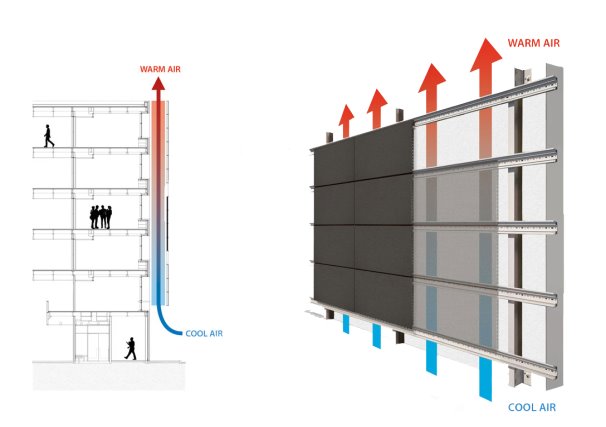
Figure 7. Rainscreen Facade operation
2.4. Cladding Materials
The cladding is necessary to create a controlled internal environment, protect the building from external conditions, prevent the spread of fire, provide thermal insulation, provide openings for access, daylight and ventilation and generate an airtight building envelope. (Watts, 2007)
There are two generic methods of joining materials which are closed joints and open joints.
Closed joints have an outer seal which is formed typically by a lap or a butt joint. This may form a single seal, as when two sheets of glass are butt joined and seal with a strip of silicone. The joint may also allow for small amounts of water to enter the joint and then drain down safely in a ventilated inner chamber back to the outside. (Watts, 2007)
In open joints, rainwater is allowed to penetrate an outer joint which is left open, but the gap allows only a small amount of water to penetrate the gap. Water entering the joint is then drained away safely in a cavity to the outside. The cavity may only be a narrow strip between two panels or may be a completely open cavity behind a series of open jointed panels. This so called “rainscreen principle” can be used in both closed joints and open joints, where either an outer seal or outer gap can protect joints in the cladding assembly from the worst effects of wind-blown rain. (Watts, 2007)
Table 2. Classification of the most common cladding materials
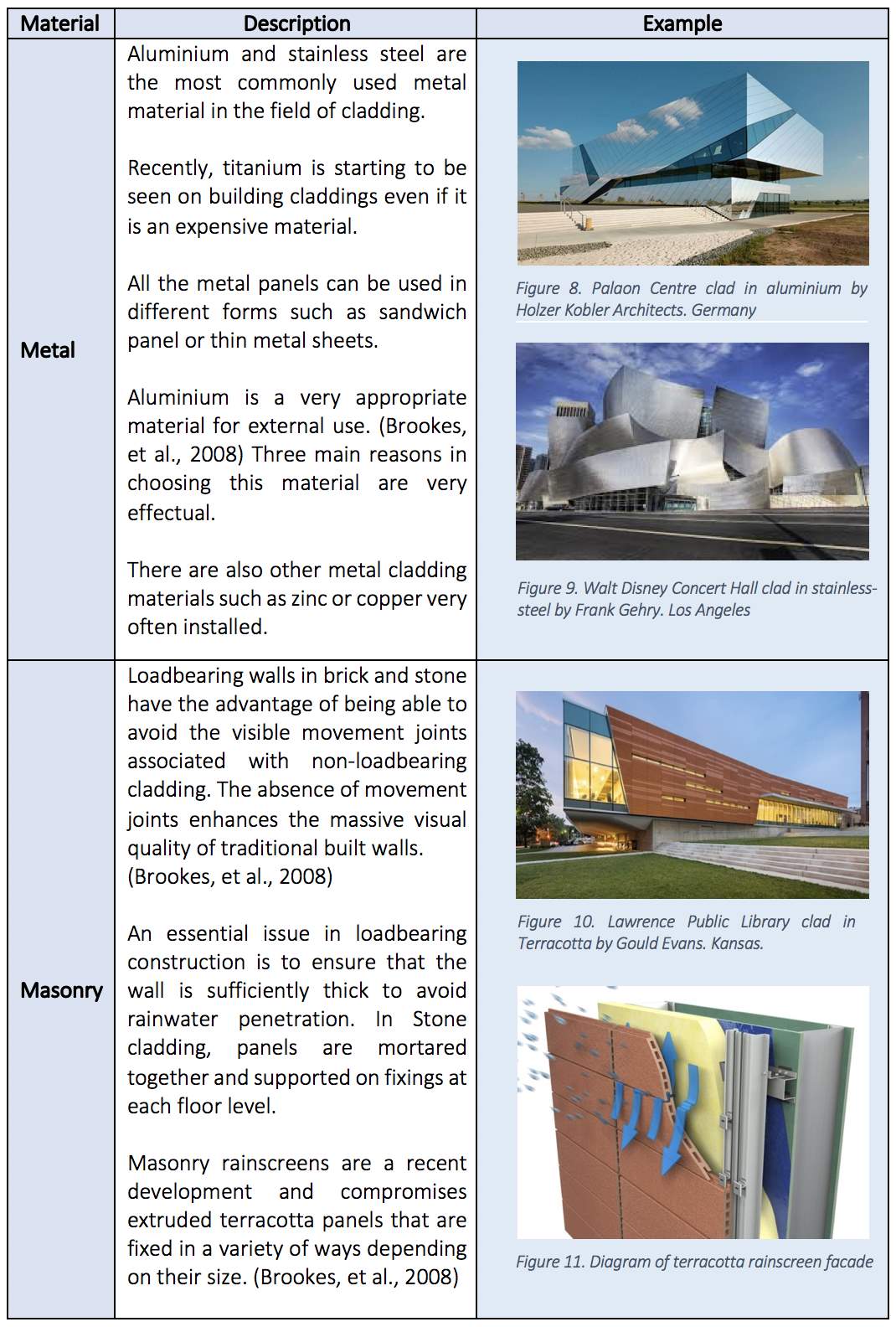
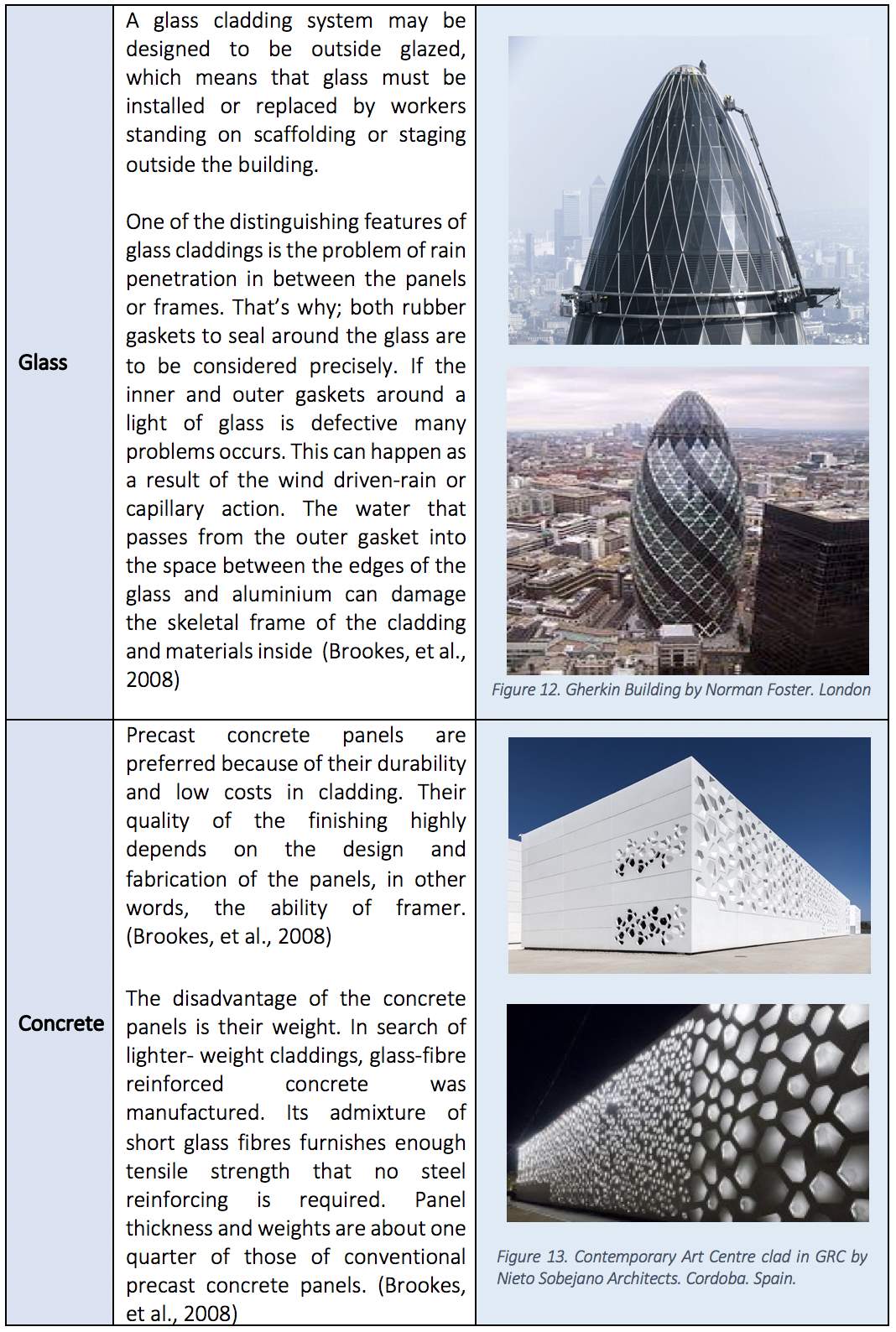
3. Timber as Cladding Material in Rainscreen Facades
Timber facades have been used in low-rise housing in North America and Scandinavia and in recent years have experienced a substantial renaissance in the United Kingdom and central Europe. Previously used primarily in low-rise housing, timber cladding increasingly appears as an external finish in medium-rise buildings, multi-occupancy housing and non-domestic applications, such as offices. As long as the timber was only used to clad low-rise single-height houses in relatively protected sites, it was easy to design and install. But the increasing use of this cladding in large and complex buildings, and in exposed sites, has increased associated risks, such as wind damage or the spread of fire. (Davies, 2015)
Timber, as distinct from other cladding materials, is biogenic (derived from living organisms) and organic. (Davis, et al., 2010)
The differences between timber and other conventional building materials are manifested through different approaches to the design of facades. Many published publications of rainwater penetration through the cladding focus on leaks through the joints between the waterproof sheet materials but ignore the flow of moisture through the cladding itself; This is an important issue for timber cladding facades. These differences between wood and more traditional cladding materials mean that some criteria in existing performance for facades are not directly transferable to timber. (Davies, 2015)
Timber now has to achieve equivalent performance standards to other, longer established, cladding materials. (Davies, 2015). Timber facades are becoming more popular in UK moving from masonry to timber cladding. A major reason for this interest is recognition of the environment benefits of timber as building material, and its visual, tactile appeal. (Davis, et al., 2010)
3.1. Characteristics of Timber as Façade Material
Timber has three main characteristics as façade material:
Table 3. Characteristics of timber as facade material

Facades are constantly exposed to fluctuating moisture conditions: the design is dominated by the relationship between wood and water. Combustibility and non-uniformity have to be managed while not increasing moisture related deterioration. This is usually done through the use timber rainscreen cladding. (Davis, et al., 2010)
3.1.1. Natural Durability
Sapwood is more resistant to degradation by organisms that destroy wood than heartwood. Timber species can be classified according to the natural durability of their heartwood. (Davis, et al., 2010).
BS EN 350 2016 which replace BS EN 350-1 gives different classification for each of the main types of wood-destroying organism. (BSI, 2016).
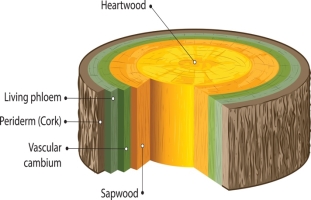
Figure 14. Heartwood Sapwood diagram
There are differences in the ecological strategy of different tree species largely explain the wide variation in biodegradation resistance between species. (Rayner, et al., 1998)
| Resistance to fungal attack (BS 350 2016) | ||
| Durability Class | Description | Example |
| 1 | Very Durable | Teak, Iroko, Yew |
| 2 | Durable | European Oak, Western red Cedar |
| 3 | Moderate durable | Douglas fir, all Larch Western red cedar maritime pine |
| 4 | Slightly durable | Douglas fir maritime pine |
| 5 | Not durable | Sitka, Spruce, all Birch, all Sapwood |
Table 4. Natural durability classification against fungi attack (BS EN 350 2016).
As it is shown on Table 4. Natural durability classification against fungi attack (BS EN 350 2016)., sapwood is not durable, so it should be removed, either at the sawmill or onsite where natural durability be important.
3.1.2. Directional Variation
It is often useful to distinguish three directional axes within a piece of timber. The radial axis describes a section from the centre of a log outwards in a radial direction. The transverse axis follows a cross section across the log, perpendicular to its length and the tangential axis describes a section tangential to the growth rings. Timber behaves differently in each of these directions. Timber is an anisotropic material and many timber properties vary according to the direction in which the straws are oriented. (Davis, et al., 2010).
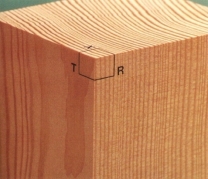
Figure 15. Timber log showing radial, transverse, tangential surfaces
3.1.3. Moisture Content
The facades are exposed to fluctuating moisture conditions and, therefore, the relationship between timber and water tends to dominate much of the design of the timber facade. Most defects in timber buildings are caused by water; either the wood was installed with the wrong moisture content for its intended use or it was moistened once in service, exceeding what was allowed for the design. (Davis, et al., 2010). The moisture content of a piece of timber is defined as the mass of water in the sample expressed as a percentage of its mass when fully dry. (Dinwoodie, 2000)

Figure 16. Weathering effects produced over the time on uncoated Scotlarch cladding at Raigmore Hospital by Russwood.
Nowadays there is a concern about how the moisture flow from outside. Moisture can penetrate walls from both inside and outside the building but control of moisture from inside the building is well understood. (Davies, 2015).
The internal structure of the materials plays an important role in this matter. The materials can be porous or non-porous. Timber is a porous material and the moisture flows by diffusion through the material itself. (Davies, 2015). Timber is described as being hygroscopic which means that it attempts to attain an equilibrium moisture content with its surrounding environment, resulting in a variable moisture content. (Kermani, 1999).
Screened walls – where the external cladding is separated from the wall structure by a cavity are common in the UK. The cavity provides a capillarity break between the cladding and substrate and promotes drying by evaporation of the wall. In a modern insulated wall, the cavity is sealed from air inside the building but may be connected to the outside. Ventilation of the cavity to the outside removes water vapour diffusing from inside a building and increases the drying rate of cladding that has been wetted by the rain caused by the wind. (Davies, 2015)
The UK’s Building regulation guidance documents recommended that the cavity should be “ventilated” as opposed to “vented”. It is important to clarify these meanings and they are defined in BS EN 5250: 2011 as:
- Vented cavity: volume of air with openings to the outside air so placed as to allow some limited, but not necessarily through, movement of air
- Ventilated cavity: volume of air with openings to the outside air so placed as to promote the through passage of air
A ventilated cavity is beneficial to reduce the risk of moisture damage within a wall as a result of interstitial condensation or the penetration of rainwater. However, the thermal resistance of a ventilated cavity is lower than if the cavity is unventilated or vented. (Davis, et al., 2010)
3.1.4. Fibre Saturation Point
The fibre saturation point is the variation of moisture content that some species can present. The moisture content can vary from below 30% to over 200%. In this condition timber is described as being green or unseasoned. Timber holds water in two forms: free and bound. Free water is present in the cavities between and within the cells whereas bound water is chemically bonded into the cell wall. Green timber contains both free and bound water. As this timber is dried, the free water is removed first until a condition is reached where all the water has gone from the cavities, but the cell walls remain saturated. (Davis, et al., 2010)

3.2. Types of Timber Cladding
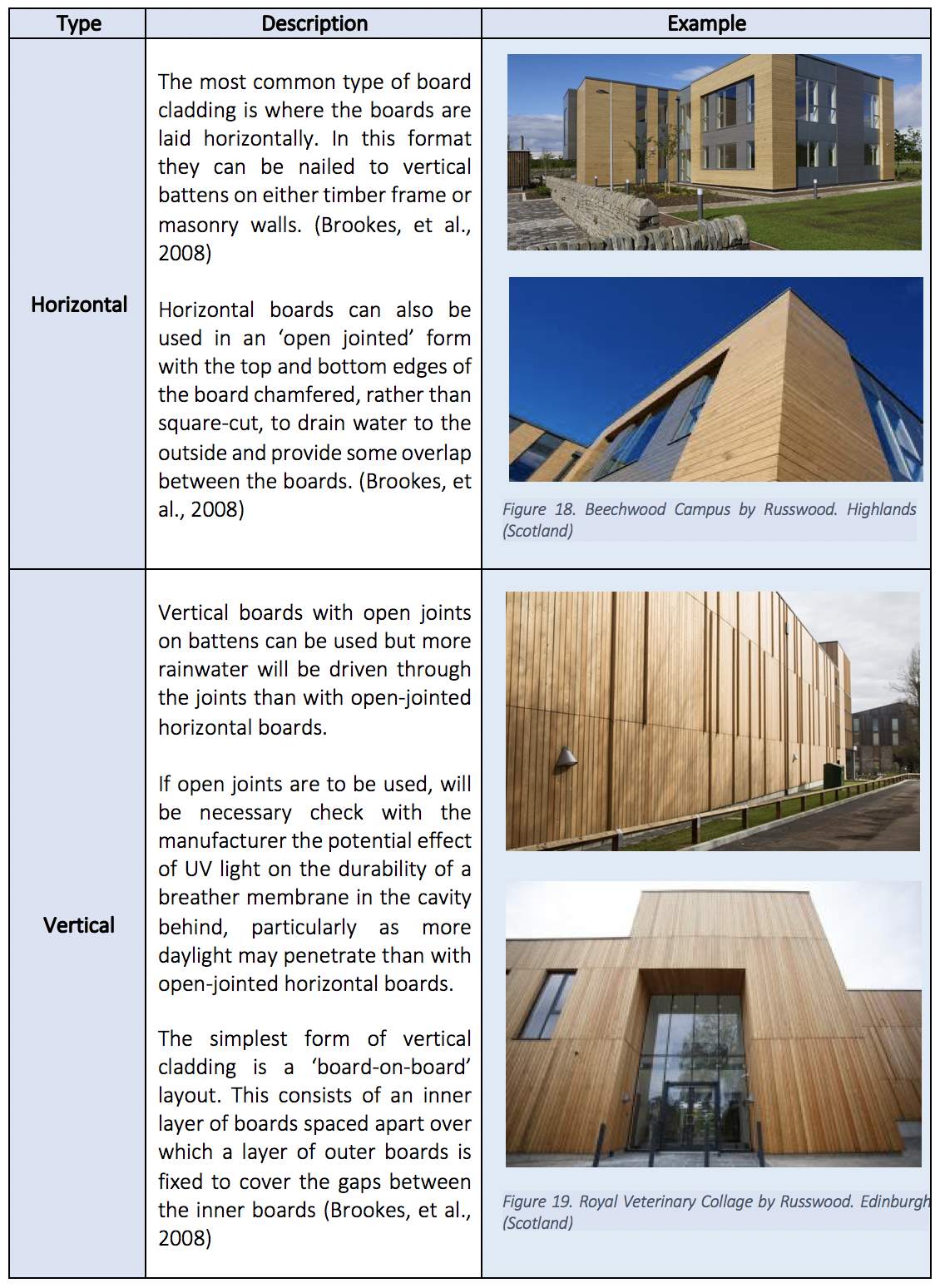
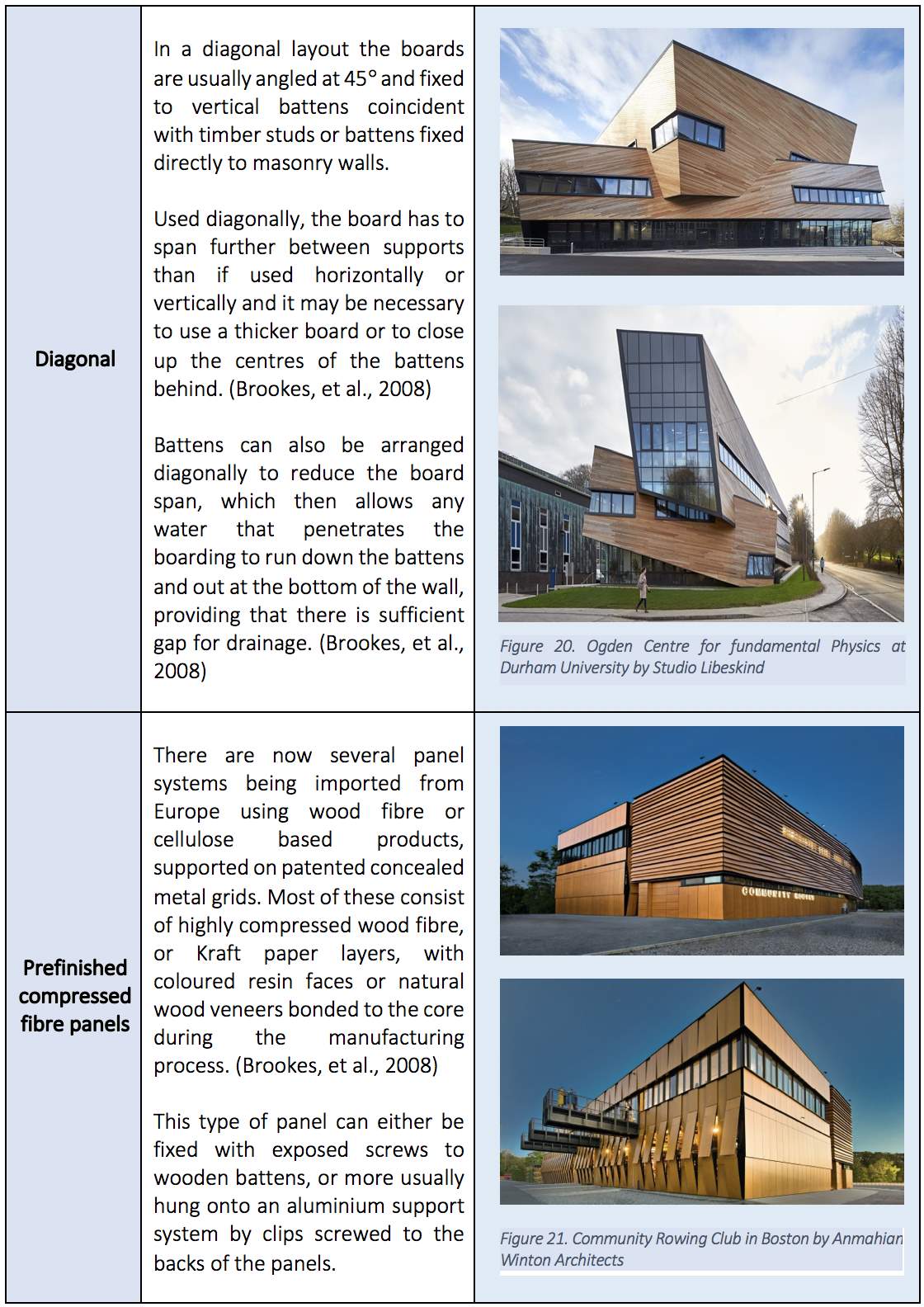
Table 5. Different types of timber cladding
4. Modified Timber
Timber has many applications in construction including: housing frames, mass timber systems and aesthetic reasons due to timber has a good strength to weight ratio and a good appearance. However, due to the disadvantages with timber (poor dimensional stability, subject to biological attack and susceptible to fungal decay) actions have been taken to improve the material. (Hill, 2006)
Nowadays, to achieve the durability required for the cladding, there are several alternatives to the use of timber treated with preservatives or natural preservation, such as chemically modified or heat-treated wood. The wood becomes more resistant to moisture absorption, which produces less moisture movement than typical unmodified wood. In some species, the modification process tends to obscure the wood. (Trada Technology Ltd, 2011)
4.1. Chemical Modification
The majority of chemical modification uses a reaction with the OH group in timber. An example of chemical modification is acetylated timber. More information regarding this process is shown in section 6. Accoya: Acetylated Wood.
4.2. Thermal Modification
The most popular method of modification treats wood in a heated environment with temperatures ranging from 180 oC – 260 oC. Temperatures less than 140 oC provide little alterations to the timber and above 300 oC destroys the materials strength. This process can take place in an environment consisting of air, a vacuum, inert gas or high-pressure steam. This is advantageous because of improved dimensional stability and resistance to fungal decay however the disadvantages include reduced impact toughness and it is more susceptible to cracks and splits. (Hill, 2006)
4.3. Surface Modification
Methods in timber modification such as batch processing make it difficult to obtain an even reaction with the selected reagents. By only requiring a reaction with the exterior of the timber, surface modification eliminates reactions of the entire product hence shortening the production times. Surface modification uses include: improving bonding to other surfaces or coatings, reduced deterioration due to ultraviolet light and reduced absorption of water.
4.4. Impregnation of Wood
Swelling the timber and impregnating the cell wall with a chemical or element is another method of timber modification known as impregnation. This in addition to other timber methods can reduce leaching or improve water transfer. However, there is little research in comparison to the other modification methods and few commercial options. (Hill, 2006)
5. Accoya. Acetylated Wood
Acetylation is a chemical modification treatment that allows an increase in weather resistance and improves the durability of wood and other natural materials. The product manufactured with acetylated wood is called Accoya and is manufactured by Accsys Technologies.
The process of adding an acetyl group to a compound such as wood to alter properties is known as acetylation. Accoya uses reactive acetic anhydride, the most effective reagent, with radiata pine.
A schematic of the reaction is shown in “Figure 22. Accoya Reaction Schematic”, where the hydroxyl groups (OH) react with the acetic anhydride to make acetylated wood with a by-product of acetic acid. The hydroxyl groups are the component that reacts with water creating swelling of the timber. By changing the hydroxyl groups to acetyl groups, Accoya has an increased dimensional stability in comparison to unreacted wood. (Hill, 2006)
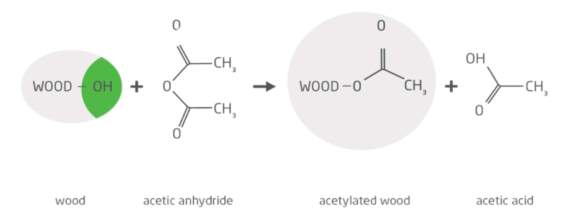
Figure 22. Accoya Reaction Schematic
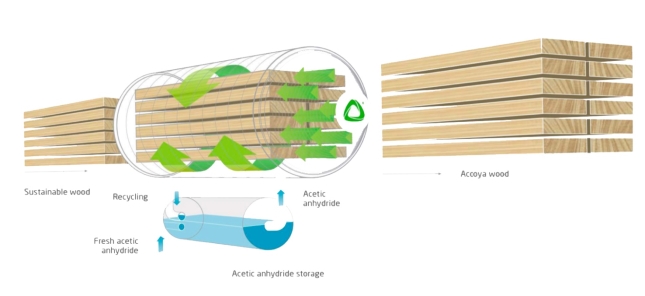
Figure 23. Accoya procurement process
5.1. Sustainability
Soft woods can be grown in sustainable plantations that have a reduced environmental impact. Radiata pine, the material used to create Accoya, can be harvested in 30 years. In comparison, tropical hardwoods can take up to 100 years or more to grow in old-grown forests. (Hill, 2010)
Due to the low density and the lower comparable mechanical properties, softwoods are still considered a less desirable material. In some parts of North America, a solution is used to treat wood with chemicals such as chromium and copper arsenic to make the product more durable. However, hazardous materials in these products have been banned mostly in the EU. Accoya remains a chemically treated wood but uses less harmful materials and is considered a more environmentally friendly alternative. (Hill, 2006)
Accoya wood competes in the market against other building materials. Accoya wood and alternative, commonly used materials have been compared in relation their greenhouse gas emissions, and the results differ between them. A number of greenhouse gas inventories have been examined to identify the cradle-to-gate emissions from other materials. The comparative results are summarised below. (Trueman, 2013)
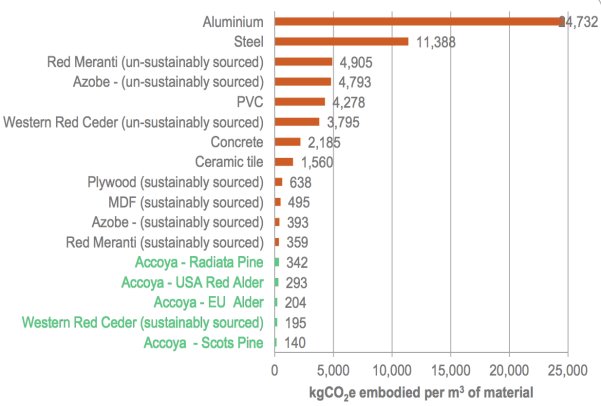
Table 6. Greenhouse gas emissions of several building materials per cubic meter based on a cradle-to gate scenario
5.2. Change Properties by Acetylation
Due to the acetylation, the chemical changes of the wood cell wall polymers are evident; the moisture absorption behaviour of the cell wall is altered due to the reactions of acetic anhydride with the hydroxyl groups. This results in a reduced equilibrium moisture content. In addition, the density of the wood increases due to the weight of the added acetyl groups. However, wood also swells during acetylation, resulting in fewer fibres per cross section than unmodified wood. (Hill, et al., 2010)
5.2.1. Reducing the Moisture Content of the Cell Wall
The equilibrium moisture content is the property by which the wood when it is in an environment and a specific humidity and relative temperature, after a period of time establishes a constant moisture content (Hill, 2010)
Acetylation reduces the equilibrium moisture content reached by wood compared to unmodified wood at the same relative humidity. But care must be taken in determining the equilibrium moisture content of acetylated wood, because modified wood weighs more than unmodified wood, so even if the moisture content of the cell wall were the same, it would appear to be less to the weight gain of acetyl. (Hill, 2010)
Figure 24. shows the effect of modifying wood with acetic or hexanoic anhydride upon the reduced equilibrium moisture content compared to unmodified wood. This shows very clearly the significant reduction in reduced equilibrium moisture content.
Equilibrium moisture
Content %
Relative Humidity %
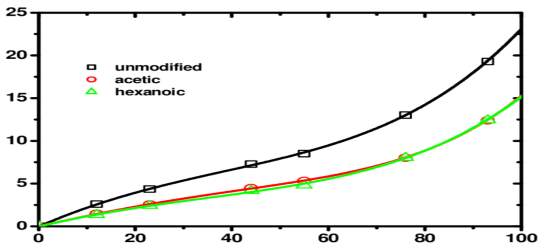
Figure 24. Reduction of the equilibrium moisture content
5.2.2. Dimensional Stabilisation
When the wood is acetylated, it is much less susceptible to shrinkage and swelling in the presence of variable atmospheric conditions. The reason is that the cell wall is now full of chemically bound acetyl groups that occupy space within the cell wall. As a result, the wood is already swollen, the extent of which depends on the level of modification, there is very little residual swelling when the wood is soaked in water. (Hill, 2010)
This significant improvement in the dimensional stability that the Accoya has on all other timber products provides a short and long-term benefit. In the short term, Accoya remains stable during processing. In the medium term, Accoya remains stable and resists movement when environmental conditions fluctuate after installation. (Hill, 2006)
Table 7 shows, the dimensional stability from fully soaked to oven dry. Where a material is unaffected by moisture changes the dimensional stability would be 100%. From oven dry to water saturated conditions, the swelling and shrinkage of acetylation wood is only minimal. (Hill, 2006)
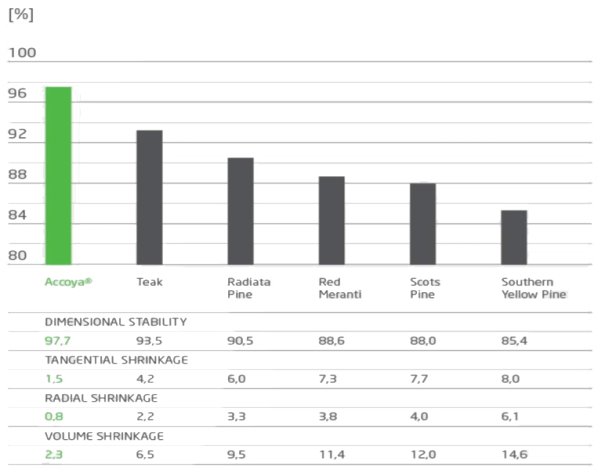
Table 7. Dimension Stability
5.2.3. Durability. Biological Degradation

Accoya wood is classified as class 1, matching and even exceeding the performance of nature’s most durable woods.

Table 8. Durability comparison
Various types of solid wood, particleboards and flakeboards made from acetylated wood have been tested for resistance to several different types of organisms. (Roweel, 2005). The results carried out concluded that as the level of acetylation goes up, the resistance to attack goes up. (Roweel, 2005).
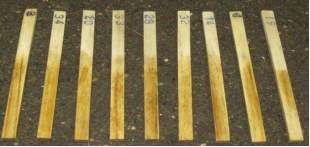
Figure 25. Acetylated pine stakes removed from the soil beds in the fungus cellar after 7 years exposure. Test by Scion, New
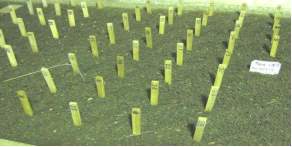
Figure 26. Acetylated pine stakes in the fungus cellar soil beds after 7 years exposure. Test by Scion, New Zealand Forest Research Institute

The Forsman Termite is one of the world’s most aggressive termites. Louisiana State University conducted a 99-day Formosan termite ‘choice’ test on 50x100mm control samples of unmodified radiata and southern yellow pine and also on Accoya.
Accoya wood
All four sizes of the unmodified wood were heavily attacked, whereas the Accoya only showed slight grazing. The results of standardised test show that Accoya is over 20 times better than the unmodified wood, measure by weight loss. (Roweel, 2005)
Non Accoya wood

Figure 27. Wood after termite test
Table 9. Weight losses. Termite test
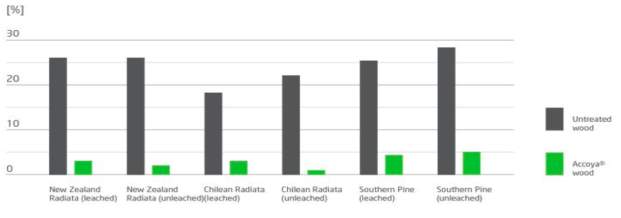
5.2.4. Mechanical Properties
5.2.4.1. Strength
The strength of timber refers to its ability to resist applied forces that could lead to its failure. While some modification processes such as thermal modification weaken wood, acetylation does not reduce its strength. (Hill, et al., 2010).
The bending strength of both unmodified, non-stress-graded radiata pine and Accoya is 80N/mm2. This is towards the middle of the range for cladding and joinery timbers, with Western red cedar being 55N/mm2 and meranti 90N/mm2. These values are obtained from standard tests on straight- grained timbers free from defects. (Hill, et al., 2010).
5.2.4.2. Hardness
Hardness is the resistance of timber to abrasion or indentation. Hardness provides useful information on how timber is likely to wear. Timber hardness is normally measured using the Janka test. (Hill, et al., 2010). The higher density and lower moisture content of radiata pine modified according to the Accoya process results in higher hardness values. Results show that acetylation increases hardness of radiata pine by 47% in the radial orientation and 52% in tangential orientation. (Hill, 2010)
6. Case Studies
6.1. Alps Villa by Camillo Botticini in Lumezzane. Italy
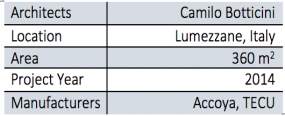
As an owner’s. requirement, Accoya was selected as cladding material for an eco-friendly property. Accoya was installed and chosen as cladding due to it is one of the most durable and stable products on the market (Prestinenza, 2015).
The architectural design of the property is expressive and impactful, using building materials such as Accoya, offering an opportunity to build something which had little impact on the environment and would help it to blend in. Accoya works both by supporting the environmental objectives of the build, as well as providing a strong, superior cladding which is able to withstand Alps weather conditions, with wet winters and hot summers with little maintenance compared to traditional timber claddings. (Prestinenza, 2015)
The house has an irregular plan shaped like a “C” with a patio where the fourth side is made from a green plane that delivers the planimetric structure that generates the spaces of the house, creating three bodies with variable height increasing from north-west, where the volume disappears by integrating into the ground. The first body has three bedrooms, two of them with windows facing the patio, through the bathroom; while the third bedroom has a subtracting that opens the master bedroom and its bathroom to the west into the clearing. To the south of the second body with a height between 3.50 and 4.50 meters introduces the living room, and open space suspended between the patio and landscape. (Prestinenza, 2015)
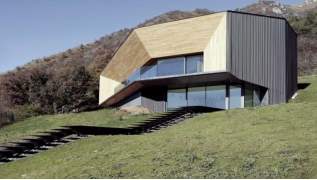
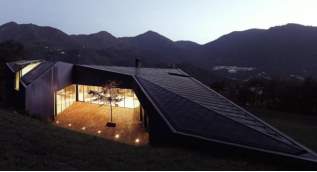
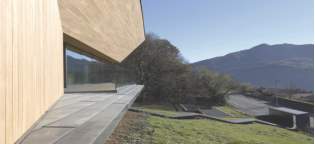
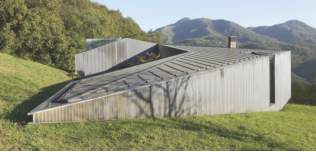
Figure 28. Alps Villa by Camilo Botticini
6.2. Europe Conference and Exhibition Centre in Vitoria. Spain
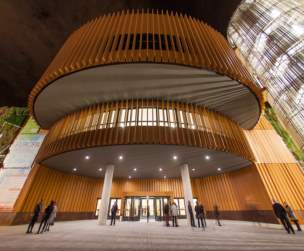
The Palacio de Congresos Europa (Europa Conference and Exhibition Centre) in Vitoria, Spain was renovated to expand its capacity and increased its environmental credentials. (Aksamija, 2016)
Originally built in 1989, renovation work began on the centre in 2011 involving the use of sustainable building materials including Accoya.
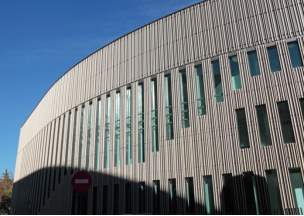
Accoya distributors “Elaborados y Fabricados Gámiz” specified the use of Accoya to City Hall Municipal Architects and IDOM-ACXT Architects as it met their environmental requirements. (Aksamija, 2016)
The environmental renovation of the centre was developed to create a carbon neutral building which is efficient in its use of resources, including building materials, water and energy use.
29m3 of 45x25mm planed Accoya sections were used to clad the Europa Conference Centre in three vertical sections of increasing density. Accoya was also specified to cover a round staircase in the conference centre’s main entrance. (Aksamija, 2016)
The building’s façade is also a “green façade” which uses more than 33,000 plants of 70 different species growing on a total surface area of 1,492 m2.
The entire façade was coated with a grey Cettol WF 771 – Sikkens AkzoNobel coating. (Aksamija, 2016)

Figure 29. Europe Conference and Exhibition Centre in Vitoria. Spain
7. Conclusion
Wood modification opens a new range of innovative applications for timber. Accoya wood is highly resistant to decay, dimensionally stable and easy to process which makes it technically suitable for use as cladding material.
Accoya’s durability is Class 1(EN 350), the highest durability class possible. This facilitates a longer lifespan which enables lower material consumption (less cladding boards replacement) over the same period compared to most of the others timber cladding materials.
Moreover, the increased dimensional stability of Accoya means that the cladding requires less coatings maintenance with the subsequent environmental benefit and lower cost. Accoya wood is sustainably sourced, non-toxic and can be safely re-used and recycled. Additionally, it is certified as such by the Forestry Stewardship Council (FSC).
Although, further studies on the performance of this modified timber product need to be carried out due to the continuous changes in the UK’s building regulations and market requirements.
Accoya as cladding material would be a suitable material to clad the Cultural Centre of Paisley.
8. References
Aksamija, A., 2016. Integrating Innovation in Architecture: Design, Methods and Technology for Progressive Practice and Research. 1st ed. London: John Wiley & Sons Ltd.
Alexander, J., Marcroft, J., Crawford, D. & Hairstans, R., 2013. Structural design with Accoya wood. International Wood Products Journal, 4(3), pp. 172-176.
Anderson,J. & Grill,R., 1988. Rainscreen Cladding: A Guide to Design Principles and Practice (CIRIA Building & Structural Design Report: Walls). 1st ed. London: Butterworth-Heinemann Ltd.
Birkeland, O., 1962. Curtain walls (Norwegian Building Research Institute. Handbook 11B). 1st ed. Oslo: Norwegian Building Research Institute.
Brookes, A., Meijs, M., 2008. Cladding of Buildings. 4th ed. New York: Taylor & Francis.
BSI, 2011. BS 5250:2011+A1:2016. Code of practice for control of condensation in buildings, London: British Standards Institute.
BSI, 2016. BS EN 350:2016.Durability of wood and woodbased products — Testing and classification of the durability to biological agents of wood and wood-based materials, London: British Standars Institute.
Capilla, A. V., Uson, A. A. & Bribian, I. Z., 2010. Life cycle assessment of building materials: Comparative analysis of energy and environmental impacts and evaluation of the eco-efficiency improvement potential, Zaragoza: Elsevier Ltd.
Condit, W., 1964. The Chicago School of Architecture. A History of Commercial and Public Building in the Chicago Area, 1875-1925. 1st ed. Chicago: Graham Foundation.
Davies, I.,2015. Development of performance-based standards for external timber cladding. Science Direct, 78(1), pp. 183-185.
Davies, I. & Wood, J., 2010. External Timber Cladding: Design, Instalation and Performance. 1st ed. Edinburgh: Arcamedia.
Dinwoodie, J., 2000. Timber its nature and behaviour. 2nd ed. London: Taylor & Francis.
Fernandez-Solis, Dixit & Culp, 2013. System boundary for embodied energy in buildings: A conceptual model for definition. Science Direct, Volume 21, pp. 153-164.
Fitch, M. & Branch, P., 1960. Primitive Architecture and Climate. Scientific American, 203(6), p. 12.
Harris, M., 2000. Dictionary of Architecture and Construction (Dictionary of Architecture & Construction). 4th ed. Columbia: Mc Graw Hill.
Hill, C., 2006. Wood Modification: Chemical, Thermal and Other Processes, Bangor: John Wiley & Sons Ltd.
Hill, C., 2010. Acetylated Wood The Science Behind the Material, Bangor: University of Wales.
Hill, C., Bongers, F., & Alexander. I., 2010. Acetylated Wood in Structural Applicatio, Edinburgh : Research Gate.
Kermani, A., 1999. Structural Timber Design. 1st ed. Bristol: Blackwell Science Ltd.
Lyons, A., 2007. Materials for Architects & Builders. 3th ed. Oxford: Elviser.
Mayo, J., 2015. Solid Wood. 1st ed. New York: Routledge.
Pomponi, F., 2016. Double Skin Façades: Life Cycle Study of a Versatile Technology for the Sustainable Refurbishment of Non-domestic Buildings, Edinburgh: Grada.
Prestinenza, J., 2015. Alpine Harmony. New European Architecture, 65(10), pp. 55-56.
Rayner, M., & Boddy. A., 1998. Fungal Decomposition of Wood: Its Biology and Ecology. 3th ed. Chichister: Wiley-Blackwell.
Roweel, R., 2005. Handbook of Wood Chemistry and Wood Composites. 1st ed. London: Taylor & Francys Ltd.
Shulz, D., 2014. Architect Morris Adjmi’s NYC Industrial Revolution – How One Architect Dares to Be Different. Starchitecture, 36(11), pp. 35-39.
Straube, J., 2006. Historical Development of the Building Enclosure. Building Science, 123(10), pp. 14-20.
Trada Technology Ltd, 2011. A Modified Wood Product, London: Accsys Technologies.
Trueman, E., 2013. Accoya wood 2012 cradle-to-gate carbon foorprint update, London: Accsys Technologies.
Turgut, C., 2007. The evolution and change of building facades, Izmir: Izmir Institute of Technology.
Unep, 2016. Towards Low-Ghc And Resilient Buildings, Nairobi: UN-Environment.
Watts, A., 2007. Modern Construction Facades. 2nd ed. Austria: Springer Science.
Cite This Work
To export a reference to this article please select a referencing stye below:
Related Services
View allRelated Content
All TagsContent relating to: "Sustainability"
Sustainability generally relates to humanity living in a way that is not damaging to the environment, ensuring harmony between civilisation and the Earth's biosphere.
Related Articles
DMCA / Removal Request
If you are the original writer of this dissertation and no longer wish to have your work published on the UKDiss.com website then please:




